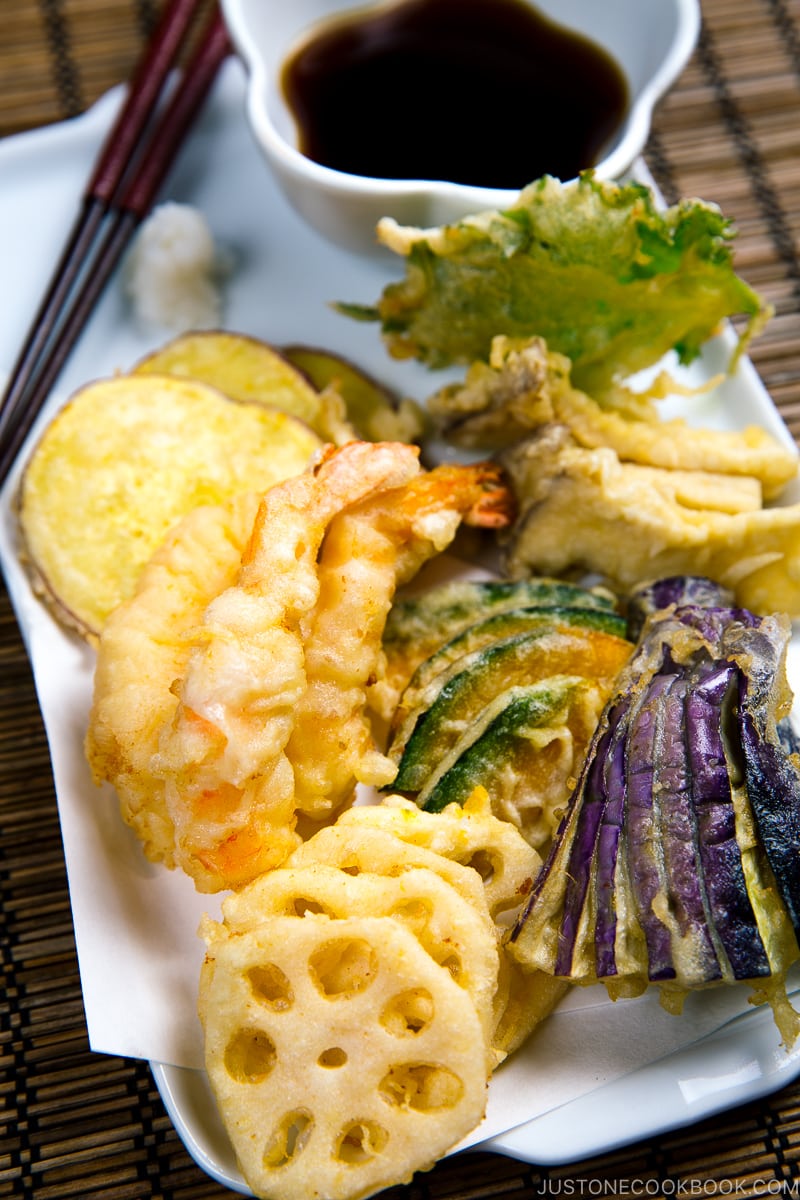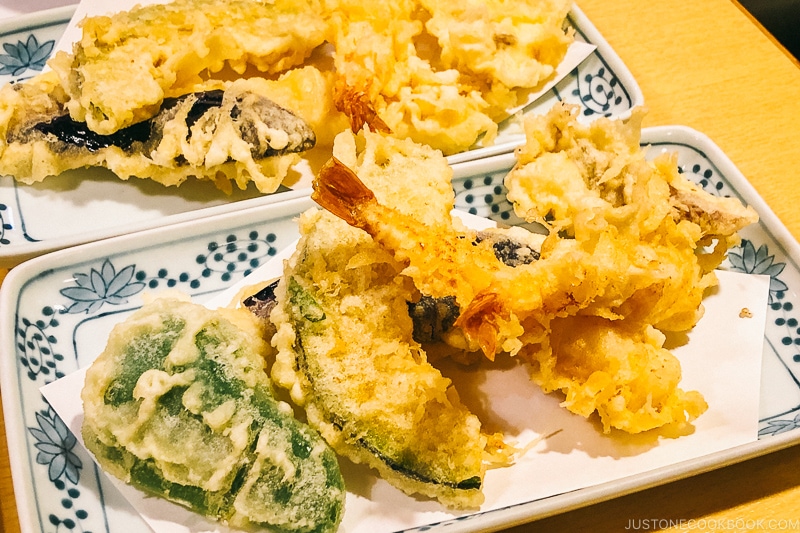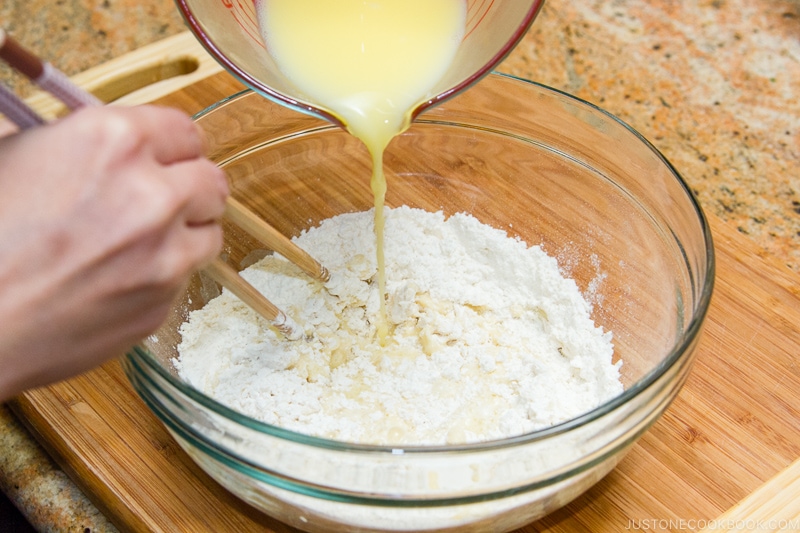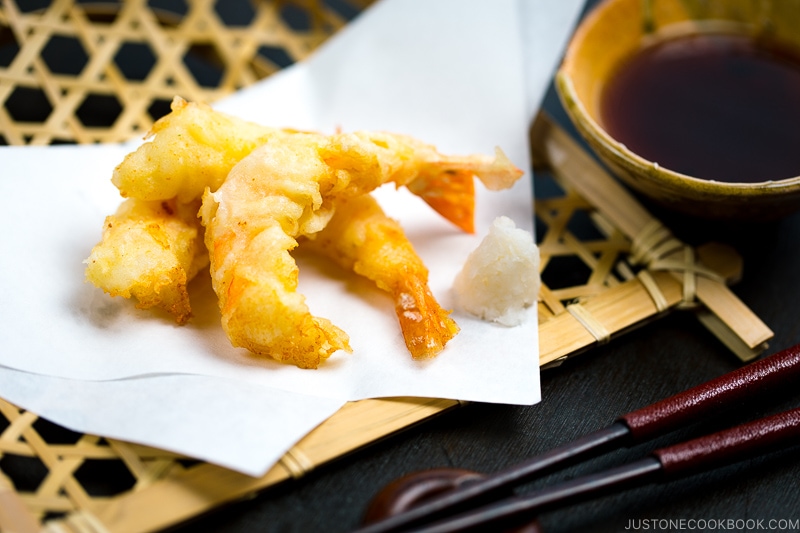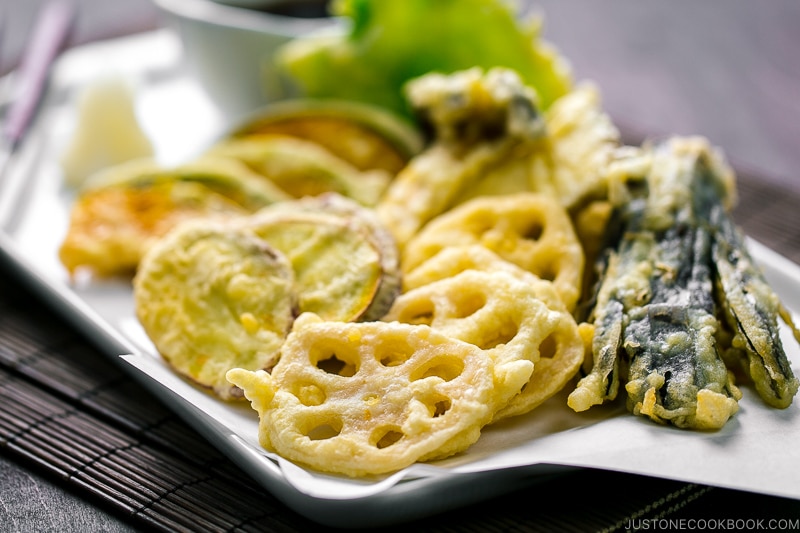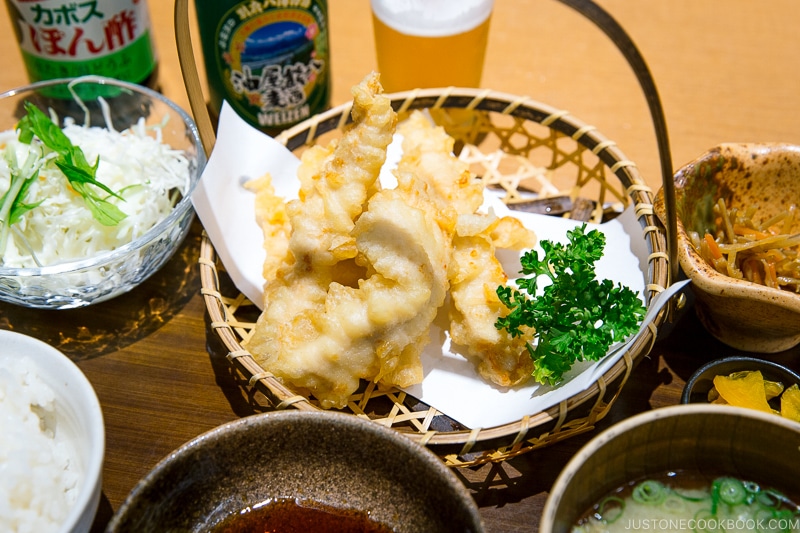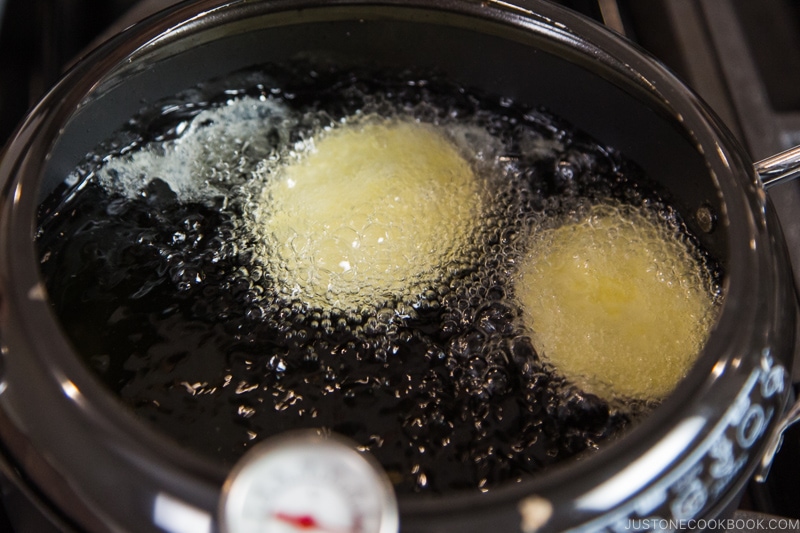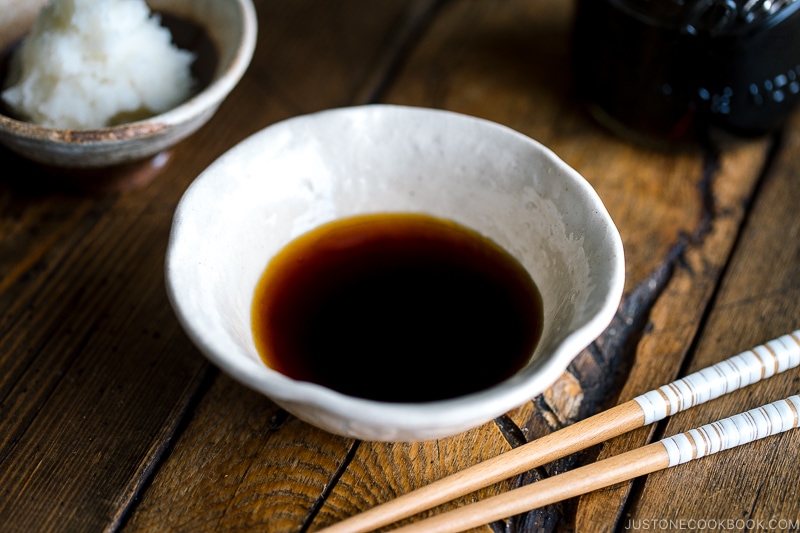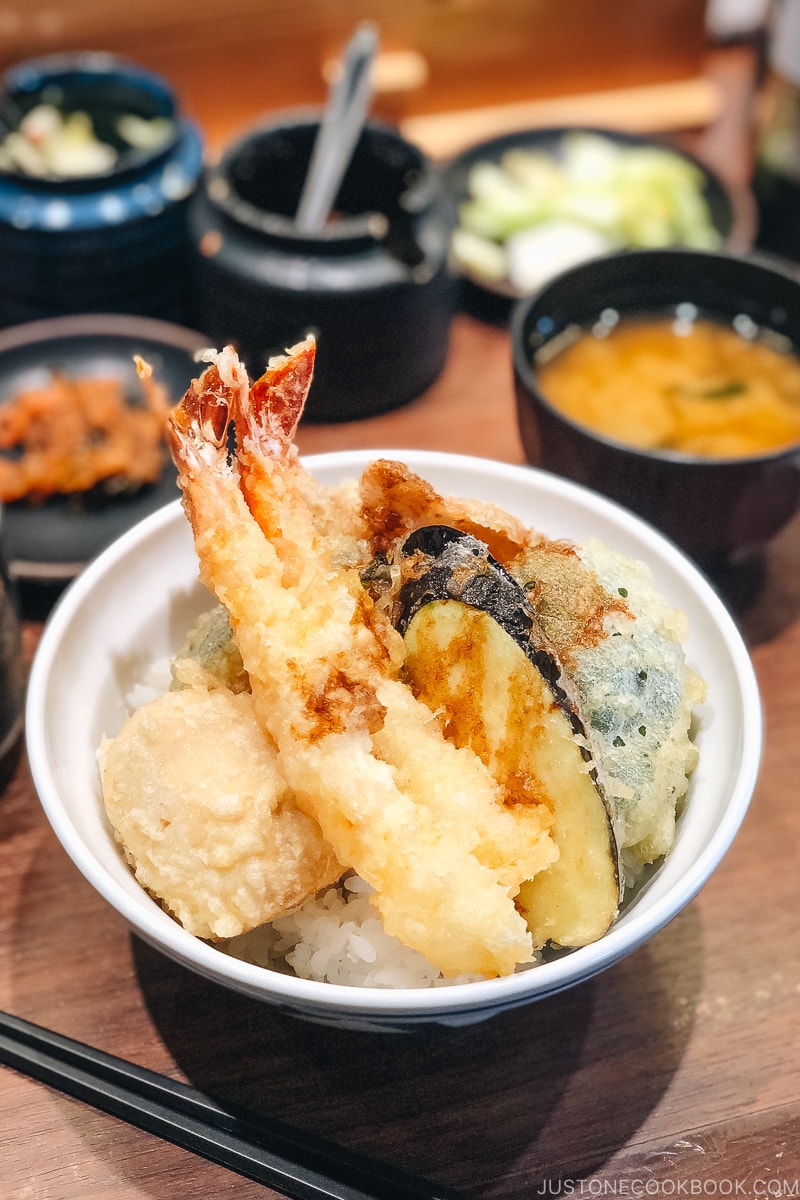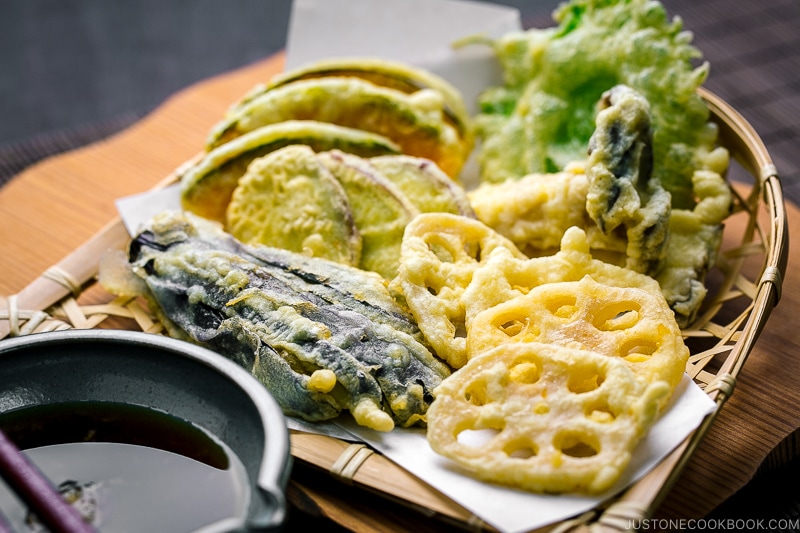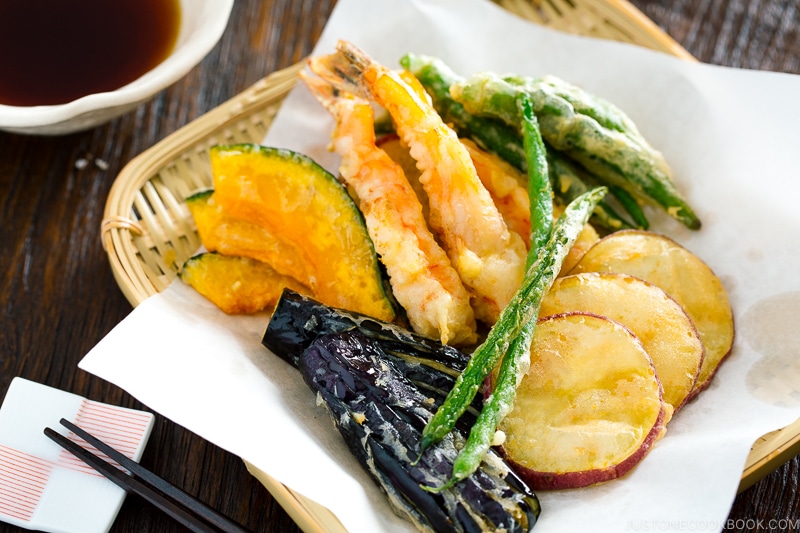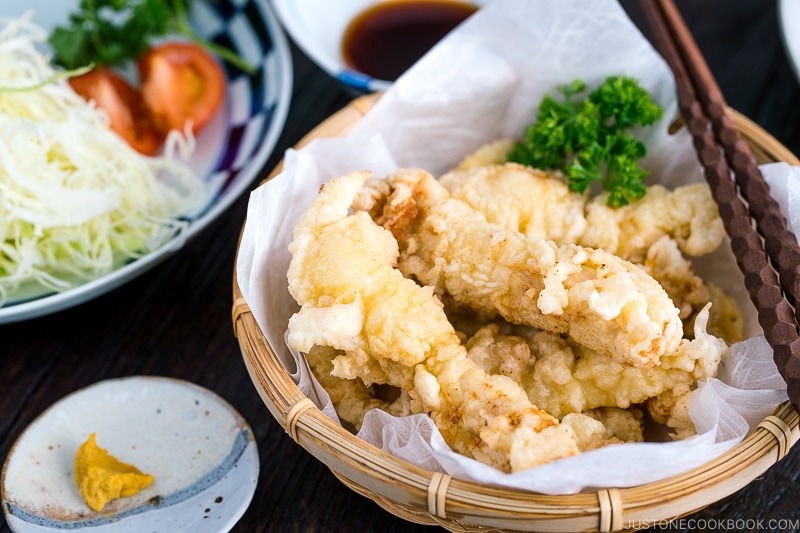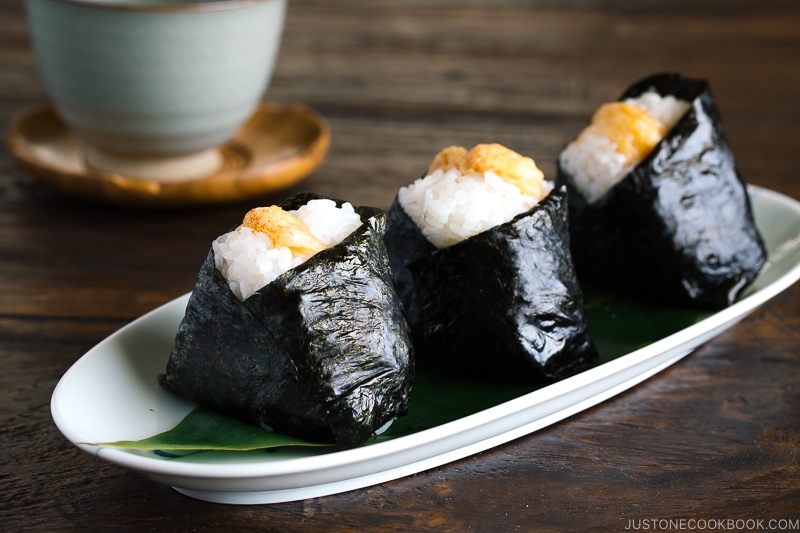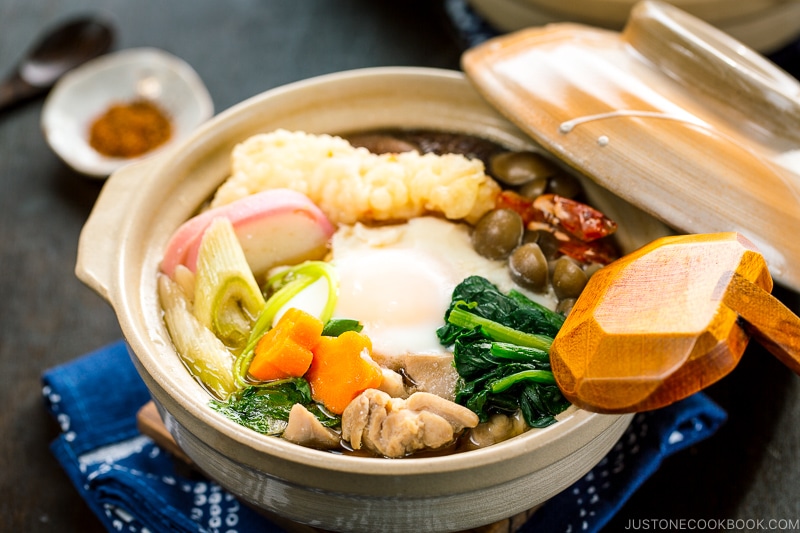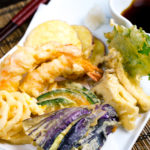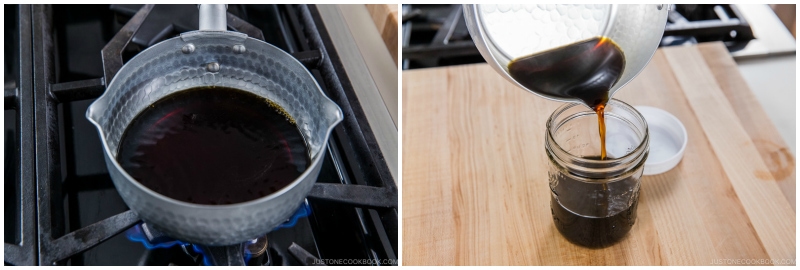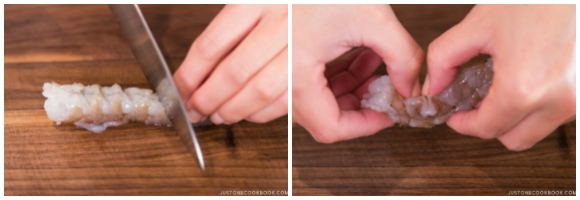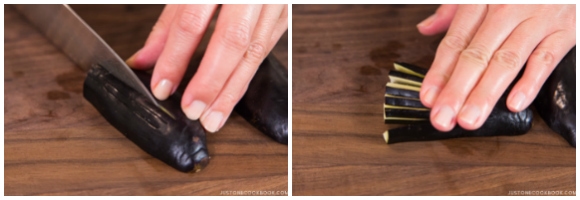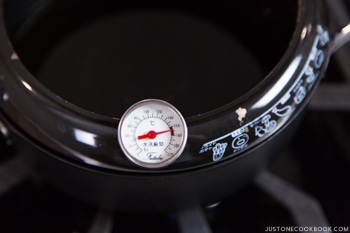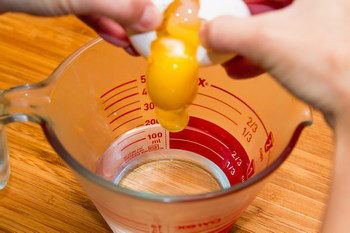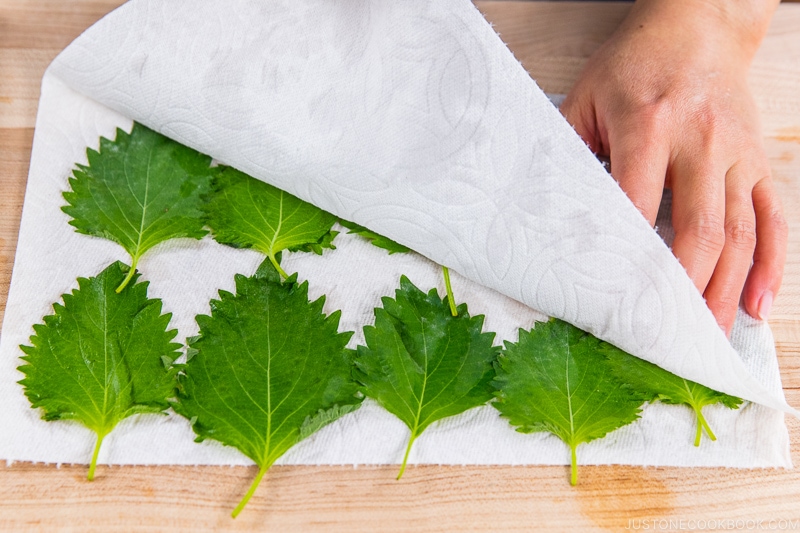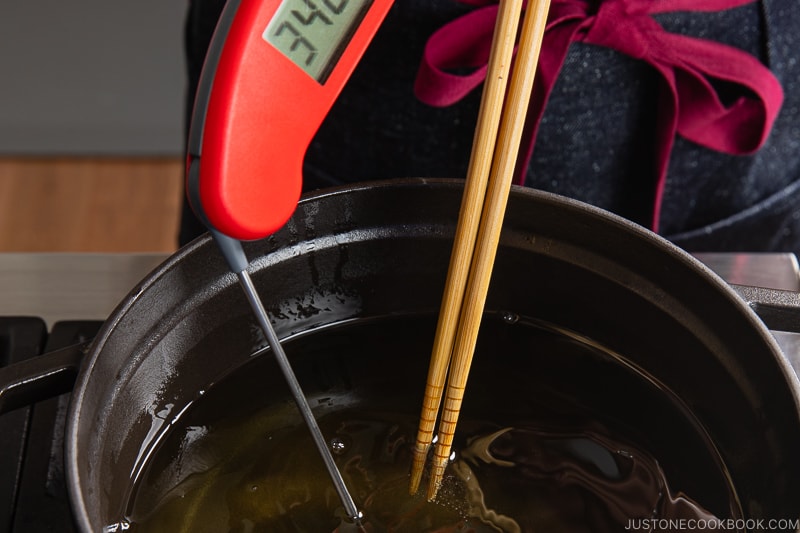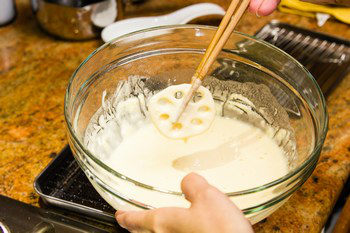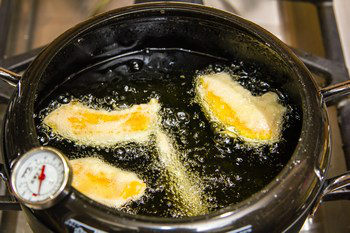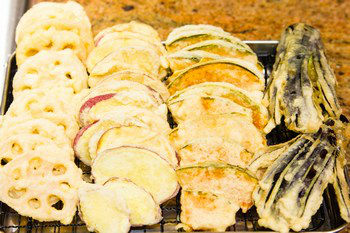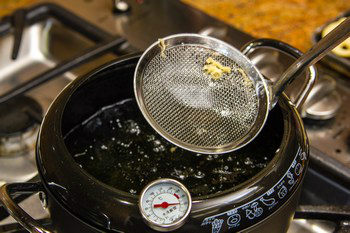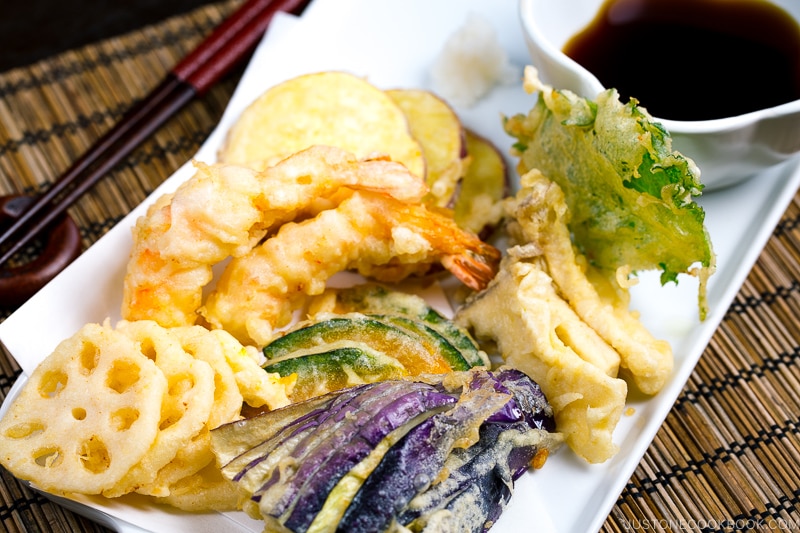When juicy plump shrimp, thinly sliced Japanese sweet potato, creamy eggplant, and fragrant shiso leaves get dunked in batter and deep-fried to light, irresistible crunch, you know you’re going to have some really good meal. In Japan, Tempura (天ぷら) is serious stuff. Japanese chefs would spend years mastering the technique of tempura frying. And home cooks will themselves in front of the hot oil in their tiny kitchens. All for the food we so love. To make tempura worthy of your effort, freshness matters. So do the batter and deep-frying technique. Sure, making perfect tempura requires skills and practice, but I am here to tell you that it is possible to make the perfectly-airy, crispy, and non-greasy tempura right from your home. Let’s learn all the secrets today!
History of Tempura
The tempura-style batter is said to have been brought to Japan by Portuguese missionaries in the 16th century, during the Muromachi period. However, as the cooking method of ‘deep-frying with flour batter’ was already established in Japan beforehand, the origin of tempura can be somewhat disputable. There are also a number of theories surrounding the etymology of tempura, which adds to the dubiety. Some sources believe the word tempura comes from ‘tempero’, which means ‘seasonings’ or ‘spices’ in Portuguese, while some cited the definition from Kanji (Japanese-Chinese characters). What’s evident is tempura started to spread as street food and became a favorite among the common people in the early Edo period. With the increase of oil production, food stalls started selling tempura as a skewered snack food, alongside soba, sushi, and eel. By the late Edo and early Meiji era, tempura shops and restaurants emerged and started establishing its position as a specialty cuisine. Today, you can find some best tempura houses in Japan, where all of your meals will be cooked by a highly trained chef who devotes his entire career to tempura frying. It cannot be any more true to say that tempura is one of Japan’s representative dishes.
How to Make The Best Tempura Batter
The success of your tempura is in the batter. To achieve a crispy texture, it’s very important to minimize the gluten formation in the batter as much as possible.
Tempura Batter: (flour : egg + water = 1 : 1 by volume)
1 cup (120 g) all-purpose flour (plain flour) 1 cold large egg (50 g without shell) 200 ml iced water
Helpful Tips:
Choice of flour – All-purpose flour is the most basic flour for tempura batter. Some people prefer using low-protein flours, such as cake flour or a mix with corn starch. For convenience, there is also a pre-mix tempura flour available. Personally, I always make my tempura batter from scratch using all-purpose flour, iced water, and egg. The recommended flour to water/egg ratio is 1:1. A cold batter is absolutely necessary – Make sure all your ingredients (flour, water, egg) and the bowl are cold. Keep your water refrigerated so it’s icy cold. This helps the batter cling on to the surface of the ingredients. Do not overmix the batter – Use chopsticks to mix for 15-20 seconds; gluten will start to form when you mix too much. It’s even helpful to leave some floury lumps in the batter. A lumpy batter contains more air and irregularities, which gives the tempura a light lacy layer that we’re after. Aim for consistency – The finished batter shouldn’t be too thin or too thick. I’ll go for a heavy cream consistency. Make batter right before you deep fry to reduce gluten activation.
Ingredients to Use for Tempura
You can basically make tempura with a wide range of fresh ingredients, with the most common options that include seafood, mushrooms, and root vegetables. There are also local tempura menus all over Japan that feature seasonal ingredients unique to the area.
Seafood
The most popular tempura is, of course, Shrimp Tempura, also called Ebi no Tempura (海老の天ぷら) or Ebi Ten (えび天). In Japan, we use Japanese tiger prawns or Kuruma Ebi (車海老) that are large in size and have a sweet, buttery flavor. In the US, you can use black tiger shrimp or jumbo shrimp for tempura. We straighten the shrimp to make it look gorgeous and here’s how to do it. You can also find other seafood being fried up. Here are some of the delicious examples:
Abalone (鮑, あわび) – summer Anago (穴子) – winter Barracuda (梭子魚, かます) Botan shrimp (牡丹海老, ぼたんえび) Chikuwa fish cake (竹輪,ちくわ) Cod (鱈, たら) Cuttlefish (墨烏賊, すみいか) Dagger-tooth pike conger, Conger pike (鱧, はも) – summer Icefish (白魚, しらうお) – winter Japanese sea bass (鱸, すずき) Japanese smelt (公魚, わかさぎ) – spring Japanese tiger prawn (車海老,くるまえび) – summer Japanese whiting (鱚, きす) – summer Octopus (蛸, たこ) Orient clam (蛤, はまぐり) Oyster (牡蠣, かき) – summer Pufferfish (河豚, ふぐ) Sakura shrimp (桜海老, さくらえび) – spring Salmon (鮭, さけ) – fall Scallop (帆立貝, ほたてがい) – winter Sea eel (穴子, あなご) Sea bream (鯛, たい) Shirako, milt, soft roe (白子,しらこ) – winter Shishamo (柳葉魚,ししゃも) Shrimp (海老, えび) Squid (烏賊, いか) Unagi (うなぎ) – winter White-flesh fish, white-fleshed fish, white fish (白身魚, しろみざかな)
Vegetables, Mushrooms & Seaweeds
For vegetable tempura, starchy root vegetables such as sweet potato, Kabocha squash, and lotus roots are most ideal. Other popular ingredients such as Japanese mushrooms (shiitake and oyster), eggplants, okra, shiso leaves, and shishito peppers are also suitable for frying in the batter. In rural Japan, people even fry up wild edible plants and shoots like dandelion and fiddleheads for tempura. When choosing vegetables, you’d want to avoid vegetables with high water content such as tomato, celery, and cucumber. They do not hold up the batter well, and the moisture will result in the vegetables getting burnt easily. Here are some of the popular vegetables, mushrooms & seaweeds for tempura:
Asparagus (アスパラガス) – spring Avocado (アボカド) Baby corn (ヤングコーン) Bamboo shoot (竹の子) – spring Bell Pepper (ピーマン) Bitter melon (ゴーヤー) Black-eyed pea (ささげ) Carrot (人参, にんじん) – winter Chestnut (栗) – fall Corn (とうもろこし) – summer Daikon (大根) – winter Eggplant (茄子, なす) Fava bean (そら豆) Ginkgo seed (銀杏, ぎんなん) Gobo, Burdock root (ごぼう) Green beans (さやいんげん) – summer Japanese Maple leaf (もみじの葉) – Common in Mino, Osaka prefecture Japanese mountain yam (山芋, やまいも) Japanese pickled ginger (紅しょうが) – Common in Osaka prefecture Japanese sweet potato (サツマイモ) – fall Kabocha (かぼちゃ) – winter Lily bulb (百合根, ゆりね) – fall Lotus root (れんこん) Maitake mushrooms (舞茸, まいたけ) – fall Matsutake mushrooms (松茸, まつたけ) – fall Mountain vegetables (山菜, さんさい) Mozuku (edible seaweed) (藻付,もずく) – Common in Okinawa prefecture Myoga Japanese ginger (みょうが) – summer Nameko (なめこ) – fall Nori seaweed (海苔, のり) Okra (おくら) – summer Onion (たまねぎ) – spring Parsley (パセリ) Potato (じゃがいも) Romanesco (ロマネスコ) Shiitake mushroom (しいたけ) – fall Shimeji mushrooms (しめじ) – fall Shishito pepper (ししとう) – summer Shiso leaves (大葉, 紫蘇の葉) Tomato (トマト) – summer White asparagus (ホワイトアスパラガス) Zucchini, Courgette (ズッキーニ)
Meat and Eggs
We don’t generally use meats because they are considered too heavy for tempura dishes. However, you can find Chicken Tempura (Toriten) in the Oita Prefecture of Kyushu region in Japan.
Chicken (鶏, とり) – Common in Oita prefecture Egg (鶏卵, たまご) Quail eggs (うずらの卵)
How to Prepare Basic Tempura Ingredients
Important Tips
Dry the ingredient with a paper towel; moisture is the enemy for achieving crisp tempura texture. The ingredient will be well-coated with batter if you sprinkle the flour lightly over it (we call sprinkling of the flour uchiko 打ち粉) before dipping into the tempura batter.
How to Make Tempura
In Japanese cooking, deep frying is an art, and it takes some know-how and practice to execute desirable results. For the case of tempura, the hot oil enhances the natural sweetness and flavors of whatever you’re frying, at the same time, devoid of greasiness. Let’s take a look at how you can achieve that at home.
Deep Frying Oil
Most tempura restaurants use untoasted sesame oil or their own special blend of oil. At home, you can also use a neutral-flavored oil such as vegetable or rice bran oil or canola oil, and simply add a touch of sesame oil for a deliciously nutty aroma. Use clean, new oil instead of used oil. Ideally, the oil should fill up to ½ of the pot. The minimum oil you need in a frying pan is 1 inch deep. The more oil you have, the more ability the oil will have to sustain its ideal temperature throughout frying.
Oil Temperature
Ideal oil temperature for frying – Depending on the ingredients, we are looking at the range of 320-350°F (160-180°C). Use a thermometer for precise temperature control, especially if you’re not familiar with deep frying. You can check the approximate temperature by dropping the batter into the oil.
High temperature (350ºF or 180ºC): the batter will come right back up. Medium temperature (340ºF or 170ºC): the batter will go to the middle of the pot and come right back. Low temperature (320ºF or 160ºC): the batter will go to the bottom of the pot and slowly come up.
Cooking Time and Temperature
Seafood & Meat (350ºF or 180ºC)
Meat (pork and chicken) – 3-4 minutes Shrimp – 2 minutes Squid – 1 minute Fish – 1 minute
Vegetables & Mushrooms (320ºF or 160ºC)
Sweet potatoes – 2-3 minutes Kabocha – 2-3 minutes Shiitake mushrooms – 1 minute Eggplant 1 minute Shishito peppers – 30-40 seconds Shiso – 15-20 seconds
Deep-Frying Tips
Do not overcrowd the frying pot with ingredients – As a rule of thumb, only half of the oil surface should be covered with ingredients. So, deep fry in batches. Keep the oil temperature steady at all times. Turn the tempura regularly to ensure even cooking. Pick up crumbs in the oil between batches – You wouldn’t want any burnt crumbs to attach to your new tempura pieces or dilute the oil flavor.
How to Make The Best Tempura Dipping Sauce
Tempura is the best when you dip them in the delicious Tentsuyu (天つゆ) or Tempura Dipping Sauce. The sauce itself is delicate but has all the sweet-savory flavor you need to accentuate the enjoyment of fresh, hot tempura.
Tentsuyu (Tempura Dipping Suace):
¾ cup (180 ml) dashi (Japanese soup stock) (or ¾ cup water + 1 tsp dashi powder) 3 Tbsp soy sauce 2 Tbsp mirin 2 tsp sugar
The tempura dipping sauce can be put together quickly. When you make homemade dashi for miso soup, save a portion to make the sauce. It will be ready in less than 5 minutes!
How to Serve & Enjoy Tempura
Serve the hot-off-the-frying-pot tempura with tentsuyu dipping sauce along with grated daikon to help refreshen your palate. It makes a remarkable main dish to enjoy on its own. Tempura also goes well with flavored salts such as matcha salt, yuzu salt, and curry salt. You can serve tempura over steamed rice like Ten Don (Tempura Donburi), or serve with chilled soba noodles (we call it Ten Zaru).
Various Tempura Recipes to Try
Hungry? Find the detailed tips and techniques in each of the following tempura recipes!
1. Shrimp Tempura
Crispy and delicious homemade Shrimp Tempura! The secret to making a light, crisp coating that doesn’t absorb oil when fried is in the batter and deep-frying technique.
2. Vegetable Tempura
Who can resist delicious crispy homemade vegetable tempura? When making tempura at home, the goal is a crispy yet airy coating that doesn’t absorb oil when deep-fried. I’ll teach you how to achieve excellent results in this recipe.
3. Gluten-Free Tempura
Yes, you can now make Gluten-Free Tempura with a crispy batter at home. This recipe will show you how.
4. Chicken Tempura
Chicken Tempura is a regional favorite in Oita Prefecture of Kyushu region in Japan. With a crispy and fluffy batter on the outside and juicy and tender meat inside, this Chicken Tempura is best enjoyed by dipping with karashi mustard ponzu sauce.
More Delicious Ways to Serve Tempura
Besides eating them straight off as a dish, you can also serve tempura as a topping or a side to accompany many other dishes like sushi and noodles. On Just One Cookbook, I have shared many recipes featuring delicious tempura such as below:
Soba Noodle Soup – Simple bowl of soba noodle soup topped with tempura, fish cake, and scallion. Ten Don (Tempura Donburi) – You get shrimp and vegetable tempura served over a rice bowl. Tensumu (Tempura Shrimp Rice Balls) – A Nagoya specialty, Tensumu is rice balls stuffed with shrimp tempura. Dragon Roll – An inside-out sushi roll featuring shrimp tempura and creamy avocado. Nabeyaki Udon – Topped with tempura, chicken & heaps of vegetables, Nabeyaki Udon is a hot noodle soup traditionally served in a donabe or iron pot.
Now that you’re armed with the knowledge of tempura-making, I hope you’re ready to fire up some delicious tempura at home! Wish to learn more about Japanese cooking? Sign up for our free newsletter to receive cooking tips & recipe updates! And stay in touch with me on Facebook, Pinterest, YouTube, and Instagram.
